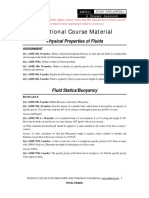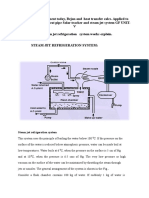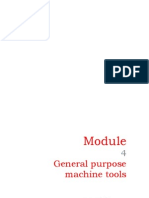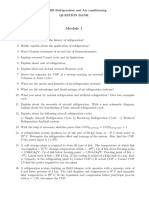0 ratings0% found this document useful (0 votes)
349 viewsGear Train
This document defines and describes different types of gear trains:
1) A gear train transmits power from one shaft to another using two or more meshing gears. There are four main types: simple, compound, reverted, and epicyclic.
2) A simple gear train has only one gear on each shaft. A compound gear train has more than one gear on a shaft to bridge space between driver and driven gears.
3) A reverted gear train has coaxial first and last gears, causing the first gear to drive the last in the same direction. An epicyclic gear train allows the gear axes to move relative to a fixed axis, like in a planet gear system.
Uploaded by
अman अmitCopyright
© © All Rights Reserved
Available Formats
Download as PDF, TXT or read online on Scribd
0 ratings0% found this document useful (0 votes)
349 viewsGear Train
This document defines and describes different types of gear trains:
1) A gear train transmits power from one shaft to another using two or more meshing gears. There are four main types: simple, compound, reverted, and epicyclic.
2) A simple gear train has only one gear on each shaft. A compound gear train has more than one gear on a shaft to bridge space between driver and driven gears.
3) A reverted gear train has coaxial first and last gears, causing the first gear to drive the last in the same direction. An epicyclic gear train allows the gear axes to move relative to a fixed axis, like in a planet gear system.
Uploaded by
अman अmitCopyright
© © All Rights Reserved
Available Formats
Download as PDF, TXT or read online on Scribd
You are on page 1/ 7
Gear Train
Gear Train
Definition:
When two or more gears are made to mesh with each
other to transmit power from one shaft to another, such
a combination is called ‘gear train or train of toothed
wheels’.
Types of gear trains:
1. Simple gear train,
2. Compound gear train,
3. Reverted gear train, and
4. Epicyclic gear train.
Simple gear train
Definition:
When there is only one gear
on each shaft as shown in
fig., it is known as simple
gear train.
When the distance between
two shafts is small, the two
gears 1 and 2 are made to
mesh with each other to
transmit motion from one
shaft to other as shown in fig.
Since the gear 1 drives 2,
therefore gear 1 is called the
driver and the gear 2 is called
Compound gear train
Definition:
When there are more than one gear
a shaft as shown in fig., it is known
as compound gear train.
Compound gear trains are useful
in bridging over the space between
the driver and the driven.
Reverted gear train
Definition:
When the axes of the first gear
and the last gear are co-axial, then
the gear train is known as
reverted gear train as shown in
figure.
Here the gear 1 drives the gear 2 in
the opposite direction.
S i n c e t h e g e a r 2 a n d 3 f o r m a
compound gear and the gear 3 will
rotate in the same direction as of
gear 2.
the gear 3 will drive the gear 4 in the
same direction as of gear 1.
hence the motion of the first gear
Epicyclic gear train
In an epicyclic gear train, the axes
of the shafts, over which the gears
are mounted, may move relative to
a fixed axis.
A simple epicyclic gear train is
shown in figure.
When a gear 1 and arm 3 and gear
2 and arm 3 have a common axis.
If the arm is fixed, the gear train is
simple and gear 1 can drive gear 2
or vice-versa, but is gear 1 is fixed
and the arm is rotated about the
axis then the gear 2 is forced to
rotate upon and around the gear 1.
Such a motion is called epicyclic.
Compound Epicyclic gear train-sun and
planet gear
You might also like
- Steam Jet Refrigeration and Vapour Absorption SystemNo ratings yetSteam Jet Refrigeration and Vapour Absorption System21 pages
- B.Tech VIII: Topic - Factors Affecting Human Comfort100% (1)B.Tech VIII: Topic - Factors Affecting Human Comfort8 pages
- Chapter 5. Ultra Low Temperature Refrigeration SystemsNo ratings yetChapter 5. Ultra Low Temperature Refrigeration Systems35 pages
- Refrigeration and Airconditioning by S K Mondal T&Q .0002No ratings yetRefrigeration and Airconditioning by S K Mondal T&Q .0002130 pages
- Lecture 31 Thermal Engineering II (23.09.2020) .No ratings yetLecture 31 Thermal Engineering II (23.09.2020) .47 pages
- 19 Kinematic System and Operations of Milling Machines.100% (5)19 Kinematic System and Operations of Milling Machines.23 pages
- Refrigeration and Air-Conditioning: Chapter OutlineNo ratings yetRefrigeration and Air-Conditioning: Chapter Outline24 pages
- LN Unit III (BME 101 Introduction To Refrigeration and Air-Conditioning) Lecture Notes 13082023No ratings yetLN Unit III (BME 101 Introduction To Refrigeration and Air-Conditioning) Lecture Notes 1308202329 pages
- Subject: Theory of Machines-II: Sample Multiple Choice QuestionNo ratings yetSubject: Theory of Machines-II: Sample Multiple Choice Question13 pages
- Maximum COP of Ideal Absorption Refrigeration System: Unit IINo ratings yetMaximum COP of Ideal Absorption Refrigeration System: Unit II4 pages
- Refrigeration and Air Conditioning Question Bank PDFNo ratings yetRefrigeration and Air Conditioning Question Bank PDF10 pages
- Theory Questions Asked in Mid Sem and CVMU QP - 07072023No ratings yetTheory Questions Asked in Mid Sem and CVMU QP - 0707202326 pages
- Gas Refrigeration System (Air Refrigeration)No ratings yetGas Refrigeration System (Air Refrigeration)30 pages
- TE - Mech - RAC - Chapter 4 - VCC Cycles-1No ratings yetTE - Mech - RAC - Chapter 4 - VCC Cycles-198 pages
- Experiment No: 1: Thermal Engineering Lab ManualNo ratings yetExperiment No: 1: Thermal Engineering Lab Manual8 pages
- Spur Gear Tooth Stress Analysis and Stress Reduction: V.Rajaprabakaran Mr.R.AshokrajNo ratings yetSpur Gear Tooth Stress Analysis and Stress Reduction: V.Rajaprabakaran Mr.R.Ashokraj11 pages
- 055 - ME8091, ME6602 Automobile Engineering - 2 Marks With Answers 2No ratings yet055 - ME8091, ME6602 Automobile Engineering - 2 Marks With Answers 216 pages
- Project Report On Power Transmission in Automobiles100% (1)Project Report On Power Transmission in Automobiles74 pages
- R19 - Mech - Turbo Machinery - Mechanical - Sample Questions Bank PDFNo ratings yetR19 - Mech - Turbo Machinery - Mechanical - Sample Questions Bank PDF9 pages
- Gear Trains: Gear Train Train of Toothed WheelsNo ratings yetGear Trains: Gear Train Train of Toothed Wheels8 pages































































